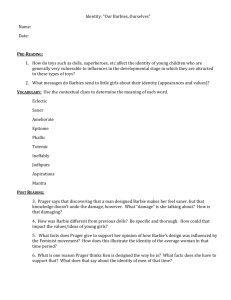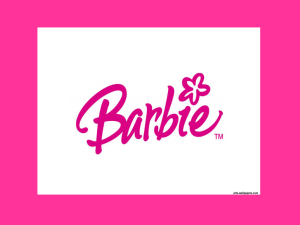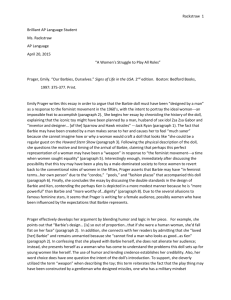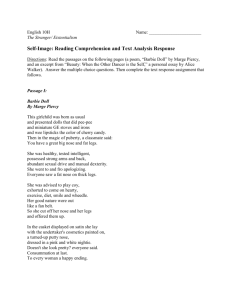Our Barbies, Ourselves: Barbie's Impact on Women
advertisement
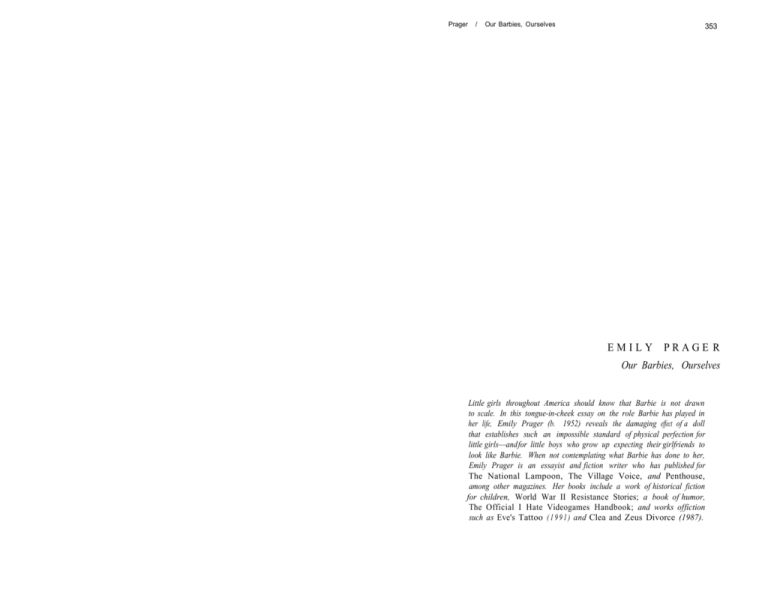
Prager / Our Barbies, Ourselves 353 EMILY PRAGE R Our Barbies, Ourselves Little girls throughout America should know that Barbie is not drawn to scale. In this tongue-in-cheek essay on the role Barbie has played in her life, Emily Prager (b. 1952) reveals the damaging effect of a doll that establishes such an impossible standard of physical perfection for little girls—and for little boys who grow up expecting their girlfriends to look like Barbie. When not contemplating what Barbie has done to her, Emily Prager is an essayist and fiction writer who has published for The National Lampoon, The Village Voice, and Penthouse, among other magazines. Her books include a work of historical fiction for children, World War II Resistance Stories; a book of humor, The Official I Hate Videogames Handbook; and works of fiction such as Eve's Tattoo ( 1 9 9 1 ) and Clea and Zeus Divorce (1987). 354 LARGER THAN LIFE I read an astounding obituary in the New York Times not too long ago. It concerned the death of one Jack Ryan. A former husband of Zsa Zsa Gabor, it said, Mr. Ryan had been an inventor and designer during his lifetime. A man of eclectic creativity, he designed Sparrow and Hawk missiles when he worked for the Raytheon Company, and, the notice said, when he consulted for Mattel he designed Barbie. If Barbie was designed by a man, suddenly a lot of things made sense to me, things I'd wondered about for years. I used to look at Barbie and wonder, What's wrong with this picture? What kind of woman designed this doll? Let's be honest: Barbie looks like someone who got her start at the Playboy Mansion. She could be a regular guest on The Howard Stern Show. It is a fact of Barbie's design that her breasts are so out of proportion to the rest of her body that if she were a human woman, she'd fall flat on her face. If it's true that a woman didn't design Barbie, you don't know how much saner that makes me feel. Of course, that doesn't ameliorate the damage. There are millions of women who are subliminally sure that a thirty-nine-inch bust and a twenty-three-inch waist are the epitome of lovability. Could this account for the popularity of breast implant surgery? I don't mean to step on anyone's toes here. I loved my Barbie. Secretly, I still believe that neon pink and turquoise blue are the only colors in which to decorate a duplex condo. And like many others of my generation, I've never married, simply because I cannot find a man who looks as good in clam diggers as Ken. The question that comes to mind is, of course, Did Mr. Ryan design Barbie as a weapon? Because it is odd that Barbie appeared about the same time in my consciousness as the feminist movement—a time when women sought equality and small breasts were king. Or is Barbie the dream date of weapons designers? Or perhaps it's simpler than that: Perhaps Barbie is Zsa Zsa if she were eleven inches tall. No matter what, rny discovery of Jack Ryan confirms what I have always felt: There is something indescribably masculine about Barbie—dare I say it, phallic. For all her giant breasts and high-heeled feet, she lacks a certain softness. If you asked a little girl what kind of doll she wanted for Christmas, I just don't think she'd reply, "Please, Santa, I want a hard-body." On the other hand, you could say that Barbie, in feminist terms, is definitely her own person. With her condos and fashion plazas and pools and beauty salons, she is definitely a liberated woman, a gal on the move. And she has always been sexual, even totemic. Before Barbie, American dolls were flat-footed and breastless, and ineffably dignified. They were created in the image of little girls or babies. Madame Alexander was the queen of doll makers in the fifties, and her dollies looked like Elizabeth Taylor in National Velvet. They represented the kind of girls who looked perfect in jodhpurs, whose hair was never out of place, who grew up to Prager / Our Barbies, Ourselves 355 be Jackie Kennedy—before she married Onassis. Her dolls' boyfriends were figments of the imagination, figments with large portfolios and three-piece suits and presidential aspirations, figments who could keep dolly in the style to which little girls of the fifties were programmed to become accustomed, a style that spasm-ed with the sixties and the appearance of Barbie. And perhaps what accounts for Barbie's vast popularity is that she was also a sixties woman: into free love and fun colors, anticlass, and possessed of real, molded boyfriend, Ken, with whom she could chant a mantra. But there were problems with Ken. I always felt weird about him. He had no genitals, and, even at age ten, I found that ominous. I mean, here was Barbie with these humongous breasts, and that was OK with the toy company. And then, there was Ken with that truncated, unidentifiable lump at his groin. I sensed injustice at work. Why, I wondered, was Barbie designed with such obvious sexual equipment and Ken not? Why was his treated as if it were more mysterious than hers? Did the fact that it was treated as such indicate that somehow his equipment, his essential maleness, was considered more powerful than hers, more worthy of the dignity of concealment? And if the issue in the mind of the toy company was obscenity and its possible damage to children, I still object. How do they think I felt, knowing that no matter how many water beds they slept in, or hot tubs they romped in, or swimming pools they lounged by under the stars, Barbie and Ken could never make love? No matter how much sexuality Barbie possessed, she would never turn Ken on. He would be forever withholding, forever detached. There was a loneliness about Barbie's situation that was always disturbing. And twenty-five years later, movies and videos are still filled with topless women and covered men. As if we're all trapped in Barbie's world and can never escape. God, it certainly has cheered me up to think that Barbie was designed by Jack Ryan. . . . Reading the Text Why does Prager say "a lot of things made sense" to her after she learned Barbie was designed by a man? What is Prager's attitude toward Ken? How do Madame Alexander dolls diiFer from Barbies? Reading the Signs 1. Bring a toy to class and, in same-sex groups, discuss its semiotic significance; you may want to focus particularly on how the toys may be intended for 356 L A R G E R THAN LIFE one gender or another. Then have each group select one toy and present your interpretation of it to the whole class. What gender-related patterns do you find in the presentations? 2. Think of a toy you played with as a child, and write a semiotic interpretation of it, using Prager's essay as a model. Be sure to consider differences between your childhood response to the toy and your current response. 3. Did you have a Barbie doll when you were a child? If so, write a journal entry in which you explore what the doll meant to you when you were young and how Prager's essay has caused you to rethink your attitudes. 4. Consider how Jack Ryan, the creator of Barbie, would defend his design. Write a letter, as if you were Ryan, addressed to Prager in which you justify Barbie's appearance and refute Prager's analysis. 5. Barbie can be seen as embodying not only America's traditional gender roles but also its consumerist ethos. Visit a toy store to learn what "accessories" one can buy for Barbie, and then write an essay in which you explore the extent to which she illustrates the "hunger for more" described by Laurence Shames (see "The More Factor," p. 25).
